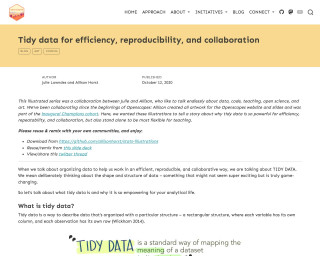Resources
This carefully curated collection of resources will help you find packages and learning resources to help you on your R journey.

The ggplot flipbook
The ggplot flipbook is a book made with xaringan that introduces the ggplot2 package in R. It explains the concept of the layered grammar of graphics and demonstrates a 'slow ggplotting' method for building plots incrementally. The book provides examples and code snippets to help users learn how to use ggplot2 effectively for data visualization.
Go to Resource

The Glamour of Graphics
In this talk, William Chase presents design principles that can be applied to transform any chart from drab to fab. He focuses on the 'Glamour of Graphics' and how it can be implemented in ggplot to improve the visual appeal and persuasive power of charts.
Go to Resource

The guide to gradients in R and ggplot2
This content is a comprehensive guide to using gradients in R and ggplot2, created by James Goldie. It covers everything from basic gradient applications to creating advanced mesh gradients within ggplot2 for enhanced visualization. The guide, published on February 24, 2025, includes examples and tutorials for applying gradient effects to various plot elements in R's ggplot2 package, utilizing functions from the 'grid' package, and considerations for themes and aesthetic choices. It also touches on the support for gradients in R version 4.1 and ggplot2 version 3.5.0, as well as how to work with system fonts and R graphics devices that support gradients.
Go to Resource

The MockUp - Creating and using custom ggplot2 themes
Creating and using custom ggplot2 themes
Go to Resource

The power of three: purrr-poseful iteration in R with map, pmap and imap
This post explores the map family of functions in the purrr package, which provide useful tools for iterating through lists and vectors in R. It focuses on map, pmap, and imap functions and their uses in manipulating multi-dimensional datasets and applying statistical models.
Go to Resource

The R Package Workflow
This text describes the R package workflow for structuring data science projects.
Go to Resource

The RedMonk Programming Language Rankings: January 2024
This content provides an overview of the RedMonk Programming Language Rankings for January 2024. Sponsored by AWS, the analysis examines programming language popularity based on GitHub pull requests and Stack Overflow discussions, aiming to forecast adoption trends rather than current usage. The methodology is a continuation of work from 2010 by Conway and Myles White, updated for changes in data sources and collection methods. While anomalies in the data suggest an impact from AI code assistants, the rankings still strive to reflect meaningful insights into language traction and potential future shifts in developer preference.
Go to Resource

The Tidy Trekker - Making Circular Maps in ggplot
Learn how to create circular maps in ggplot using R, with a step-by-step tutorial and code examples.
Go to Resource



Tidy data for efficiency, reproducibility, and collaboration
This illustrated series discusses the power of tidy data for efficiency, reproducibility, and collaboration in data science. It emphasizes the importance of organizing data in a structured and standardized format, which enables the use of existing tools, facilitates collaboration, and enhances reproducibility. The series provides examples and resources for working with tidy data and highlights its benefits in data analysis and research.
Go to Resource